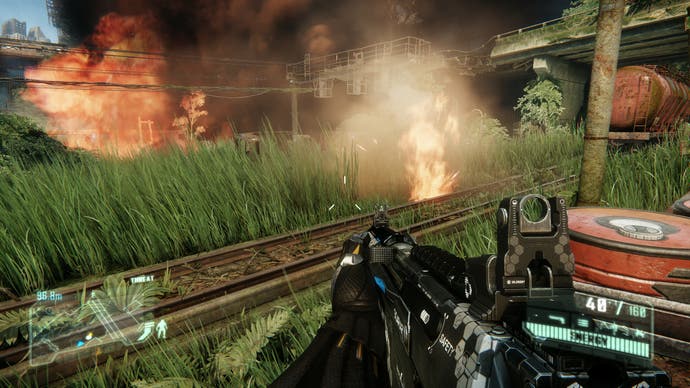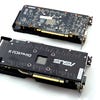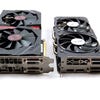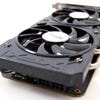Radeon R9 380 2GB vs 4GB review
The case for more VRAM becomes clear as two versions of the same GPU face off.
AMD's 300 series graphics cards aren't getting a lot of love from the enthusiast community right now and on the face of it, it's not difficult to see why - each and every one of the products is a retooled version of existing processor designs, and the only actual new technology coming from AMD is the new Fury line of GPUs. But as the 'Rebrandeon' controversy continues, one thing is clear - regardless of whether the GPU itself is old or new, the performance is good and the fact that it now ships with 4GB of RAM is absolutely crucial.
Sitting in the £150-£180 price tier, this market sector is one of the most important for both Nvidia and AMD. While the halo products like Fury X and GTX 980 Ti command the headlines, it's cards like the R9 380 and the GTX 960 that actually shift volume. It's also an area where AMD can make hay: Nvidia has just one product in this sector - and right now, we stand by our assertion that the GTX 960 is a card that's "good, but not great".
With the Radeon R9 380, what we're dealing with is effectively a slightly retooled version of the R9 285 we reviewed last September. There's some evidence to suggest a performance improvement between the two cards in like-for-like testing scenarios, but right now it seems clear that the biggest leaps in performance we see in our testing come from a better driver, which is currently only functional on older cards via unofficial hacks - though a unified driver must surely be coming sooner rather than later [UPDATE 9/7/15 10:03am: AMD has just released Catalyst 15.7 which appears to bring all the 300 series optimisations to 200 series owners]. The key issue here is that AMD is selling the R9 380 at a premium over the older 285, which has been on sale for as low as £120 across the last few months. To all intents and purposes, it could be suggested that with the 2GB R9 380, AMD has hiked prices for no substantial improvement in hardware performance - and that rankles.
However, on the flip side, this market sector needs 4GB offerings - the R9 380 at its top-end configuration is generally cheaper than the GTX 960 equivalents, and as we'll see, it's generally faster too. There's still the sense that prices overall are a little too high (especially bearing in mind the value offered by 200 series cards still in the channel) but let's not forget that launch prices for new graphics hardware are always somewhat on the high side, so we may well see costs for the 4GB R9 380 drop lower than the £175-£180 we're seeing now.
- Order the Radeon R9 380 2GB or the R9 380 4GB from Amazon with free shipping
We received a 2GB version of the R9 380 a couple of weeks back, and it's a beauty. It's an Asus Strix model, featuring beautiful workmanship, state of the art cooling, and extremely quiet performance - even at full load. But the 2GB card is just one part of the story. We were keen to test the 4GB version of the R9 380 too - in fact it was essential, bearing in mind that our most stinging criticism of the existing R9 285 and indeed the GTX 960 was the contention that 2GB of VRAM simply isn't enough for modern PC gaming. XFX came to the rescue, supplying us a 4GB sample with its 'Double Dissipation' cooler that - on paper, at least - should overpower the Asus offering in memory-intensive games. While the XFX model has the memory allocation we're looking for, the cooler is noticeably louder; overall build quality and materials aren't up to the same standard as the Strix. However, it should be pointed out that both vendors sell 2GB and 4GB versions of the R9 390 - the samples we reviewed were simply what was available at the time.
Moving on, it's safe to say that we never quite warmed to the R9 380's predecessor - the R9 285. VRAM allocation apart, our initial review was positive but later on, when it came to comparing the card with the GTX 960, our wider-ranging, more recent benchmarking suite produced some problems - summed up best by some truly woeful performance in Assassin's Creed Unity. There was the sense that the stability wasn't quite there, which extended to the recent Batman Arkham Knight debacle, where the 285 performed poorly compared to its competitors. Combine that with the 2GB VRAM limitation and it's difficult to avoid the conclusion that AMD's existing Radeon R9 280 - with its 3GB of memory and slightly slower, but more reliable performance - was the better pick.
As we kick off with our first test - the Crysis 3 gameplay challenge - initial impressions suggest that we are in much the same territory as we were with its predecessor. The R9 380 is faster than the 280, but only marginally ahead of the GTX 960 - and bearing in mind that virtually all the cards in this segment are factory overclocked to varying extents, it's safe to say that "real world" performance may be even closer, depending on which version you buy.
| Crysis 3 1080p60/V-Sync Gameplay | R9 380 | GTX 960 | R9 280 |
|---|---|---|---|
| Lowest Frame-Rate | 41fps | 40fps | 40fps |
| Dropped Frames (from 18650 total) | 539 (2.9%) | 689 (3.7%) | 840 (4.5%) |
Order the graphics cards tested against the R9 380 from Amazon with free shipping:
So if there's something of a factory overclocking melting pot in this area of the market, let's be clear about what we are working with in this piece. The Asus R9 380 2GB we have is very close to reference standard, albeit with a 20MHz boost to the reference 970MHz core clock. We get the same clocks on our XFX 4GB Double Dissipation model, though memory is slightly faster - 5700MHz vs 5500MHz on the 2GB offering. Meanwhile, our MSI GTX 960 isn't of reference spec either - it has a fairly meaty 100MHz overclock to its 1126MHz base speed.
This all translates into a healthy state of affairs for the R9 380 during the all-important 1080p benchmark run, where we see AMD's latest match or exceed its Nvidia competition in all but one game - Battlefield 4. But what is especially of interest are the results on Ryse, Assassin's Creed Unity and Far Cry 4, where the 4GB version of the R9 380 produces noticeable improvements of the 2GB card. In the table below, the 2fps uplift may not seem like a big deal, but we would strongly suggest that you watch the video to see the difference visualised - stutter in each of those titles is considerably reduced with 4GB on tap. It's also no surprise to see that the older 3GB R9 280 also does well, presumably owing to its additional gig of VRAM over the 2GB cards. The bottom line is clear: these games stutter less with more VRAM, and it seems that 2GB isn't enough to house top-end texture quality on certain games.
On top of this, something else sticks out too - the R9 285 2GB results are poor in some areas. It's supposed to be the same chip as the R9 380, just with lower core clocks (973MHz in the case of our Gigabyte Windforce sample). However, Battlefield 4 and Tomb Raider are slower than expected, while Assassin's Creed Unity is a mammoth 39.9 per cent faster on the R9 380. Clearly something is amiss and the driver is the prime culprit.
| 1920x1080 (1080p) | R9 380 2GB | R9 380 4GB | GTX 960 2GB | R9 280 3GB | R9 285 2GB |
|---|---|---|---|---|---|
| Assassin's Creed Unity, High, FXAA | 46.5 | 48.8 | 42.7 | 42.2 | 32.6 |
| Battlefield 4, Ultra, 4x MSAA | 47.9 | 47.8 | 49.4 | 47.0 | 44.9 |
| Crysis 3, Very High, SMAA T2x | 50.3 | 49.8 | 47.2 | 46.1 | 49.9 |
| Far Cry 4, Ultra, SMAA | 50.7 | 53.8 | 48.1 | 53.7 | 49.1 |
| Shadow of Mordor, Ultra, Medium Textures, FXAA | 62.7 | 64.1 | 52.8 | 58.7 | 62.1 |
| Ryse, High, SMAA | 47.8 | 49.5 | 42.4 | 49.8 | 46.7 |
| Tomb Raider, Ultimate, FXAA | 69.5 | 70.0 | 66.9 | 63.3 | 61.3 |
| The Witcher 3, High, No HairWorks, Custom AA | 49.7 | 49.2 | 47.3 | 41.6 | 47.7 |
As we move onto 1440p, scaling up resolution obviously sees a fairly heavy hit on frame-rates. For the most part, averages stay above 30fps, but the reality is that in our test areas, only two games consistently remain above the 30fps threshold from start to finish - Tomb Raider and Shadow of Mordor. Despite some marketing suggesting that the R9 380 is good for 1440p gaming, our contention is that all of these cards are best deployed at 1080p, and even then settings will need tweaking to get anything approaching a consistent 60fps (just as we dropped Crysis 3 down from very high to high in our initial test).
At 1440p, we would expect the 384-bit memory bus of the R9 280 to show a more sustained advantage up against the 256-bit and 128-bit interfaces of the R9 380 and GTX 960 respectively, but the reality is that all of the cards we tested scale up fairly well. However, once again, the numbers don't do justice to the reality of the 2GB/4GB divide between the two R9 380s. Latency spikes are even more pronounced on the affected games, with Far Cry 4 in particular suffering badly on the 2GB model - far more so than the 2GB GTX 960, curiously.
The good news for those looking for a bargain is that while the R9 280 is undoubtedly slower overall than its replacement, the stability we want is still there. To cut to the chase: a 4GB graphics card is nice, but 3GB gets the job done right now in all of our test titles. It's at 2GB that you'll start to face problems, and while the GTX 960 doesn't stutter as much as the 2GB 380, you'll still run out of VRAM and incur issues. Once again, the old R9 285 continues to be noticeably slower on Tomb Raider, Battlefield 4 and especially in Assassin's Creed.
| 2560x1440 (1440p) | R9 380 2GB | R9 380 4GB | GTX 960 2GB | R9 280 3GB | R9 285 2GB |
|---|---|---|---|---|---|
| Assassin's Creed Unity, High, FXAA | 27.3 | 31.4 | 25.2 | 28.6 | 23.7 |
| Battlefield 4, Ultra, 4x MSAA | 31.6 | 31.5 | 31.9 | 31.9 | 29.8 |
| Crysis 3, Very High, SMAA T2x | 31.6 | 31.3 | 28.3 | 29.6 | 30.6 |
| Far Cry 4, Ultra, SMAA | 36.5 | 39.5 | 33.7 | 39.4 | 36.1 |
| Shadow of Mordor, Ultra, Medium Textures, FXAA | 46.5 | 46.3 | 37.8 | 43.6 | 45.0 |
| Ryse, High, SMAA | 33.0 | 35.6 | 30.2 | 36.5 | 32.8 |
| Tomb Raider, Ultimate, FXAA | 47.7 | 47.7 | 42.2 | 42.4 | 39.5 |
| The Witcher 3, High, No HairWorks, Custom AA | 33.5 | 33.2 | 30.4 | 30.0 | 32.5 |
When AMD released the 300 series graphics cards, it produced a new driver - 15.15 - which doesn't function out of the box on 200 series cards. Owners of existing Radeons have a new 15.6 beta driver, and that's how we benched the 285 and 280. However, as we revealed in our recent R9 390X review, a hacked version of 15.15 is available that does indeed run on older AMD cards, with no noticeable impact to functionality or performance. Using that driver, we effectively demonstrated that 390X is just a faster 290X and with the 'unofficial' driver installed on the R9 285, we see much the same thing.
The bottom line is that much of the performance deficit on the R9 285 in Assassin's Creed Unity, Tomb Raider and Battlefield 4 is eliminated. DICE's shooter sees the most subtle improvement - it's about four per cent faster. However, Lara Croft's 2013 reboot get a more substantial ten per cent uplift with the hacked driver installed, while the difference in Assassin's Creed Unity is astonishing: our test sequence is 39 per cent faster on average.
This presents a couple of awkward questions - like why the drivers were forked in the first place, and why only 300 series owners got the enhanced performance. We'll keep you updated on this, but with the cat out of the bag, so to speak, we expect to see unified drivers in the not too distant future. [UPDATE 9/7/15 10:03am: We've now tested the new Catalyst 15.7 driver and can confirm that 15.15 optimisations are now running on 200 series cards - excellent news.]
| 1920x1080 (1080p) | R9 380 2GB 15.15 | R9 380 4GB 15.15 | R9 285 2GB 15.15 | R9 285 2GB 15.6 |
|---|---|---|---|---|
| Assassin's Creed Unity, High, FXAA | 46.5 | 48.8 | 45.4 | 32.6 |
| Battlefield 4, Ultra, 4x MSAA | 47.9 | 47.8 | 46.7 | 44.9 |
| Tomb Raider, Ultimate, FXAA | 69.5 | 70.0 | 67.2 | 61.3 |
In terms of power draw, our intense Crysis 3 testing scene throws up some curious metrics. The 4GB version of the R9 380 seems to be slightly more efficient than the 2GB model - which may well come down to the varying board designs from Asus and XFX. Also interesting is that power consumption on the older R9 285 is higher, despite its slower clocks. Again, this could be down to a different board design, but equally, it may well be the case that AMD has slightly tweaked the Tonga processor design for the 300 series refresh to make it a little more power efficient.
The old Tahiti-powered R9 280 is the most power hungry card out of the batch, but the XFX Double Dissipation version we have is a remarkably sturdy and well-built card that we still recommend highly - curiously, it is a lot quieter than the R9 380 we have on test here, despite the higher power consumption. Even so, despite the age of the Tahiti processor and its reputation for heat generation, it only sucks up 22-25W more than the R9 380.
Finally, there's no prizes for guessing which card is the most efficient out of the bunch - it's clearly the GTX 960. Nvidia's Maxwell architecture is built with mobile primarily in mind, and even when the design is scaled up for desktop processors, it's still remarkably cool, and light on overall power consumption. It's draws almost 100W less than the R9 280 and over 70W less than the R9 380. If you're building a small form factor PC that requires a cool and quiet card, there's only one choice here - Nvidia.

| R9 380 2GB | R9 380 4GB | GTX 960 | R9 280 | R9 285 | |
|---|---|---|---|---|---|
| Peak System Power Draw | 282W | 279W | 207W | 304W | 287W |
AMD Radeon R9 380: the Digital Foundry verdict
The R9 380 is a good graphics card that sees software optimisation and clock-speed boosts combine to turn an existing, unexciting GPU into a product that is worthy of serious consideration. It's faster than the GTX 960 on aggregate in terms of benchmarks, but that's not really important bearing in mind that the experience you get is very, very similar between both 2GB cards. What makes the 380 a genuine contender is that the extra performance is matched by a 4GB option that doesn't cost the earth.
However, as good as the R9 380 is overall, there is still the sense that just like the R9 390X, AMD is pushing its existing architectures closer to their limits in order to compete more effectively. The R9 380 is not a particularly outstanding overclocker - we could only add 60MHz to the core clock on the Asus Strix model, taking us to 1050MHz, while RAM topped out at 6100MHz. The bottom line is that overclocking only gave us 1-3fps extra on seven of our eight test games at 1080p, with Tomb Raider doing best, rising by 5fps. The GTX 960 does better, but as our test card already has a factory OC in place, at best we're only talking about a small boost over the R9 380 - not enough to noticeably transform the experience.
In that respect, there remains the sense that we're still waiting for the definitive 1080p sweet spot card - a product as disruptive to the market as the GTX 970 was when it launched. The R9 380 4GB is a good buy and a very useful option, but perhaps not the complete knock-out punch we were hoping for. Indeed, we still have a soft spot for the R9 280: 3GB is enough to run games at 1080p without the stuttering seen on the 2GB cards - for now, at least - and at anything between £130-£150 (while stocks last) it still offers an enticing overall package.
Overall though, it's good news for AMD: it has two attractive options in a very important market sector, offering 3GB and 4GB cards in a market where VRAM allocation is becoming much more important than relatively minor differences in overall performance. However, going forward, we just hope that the next-gen products in this sector embrace reality and adopt 4GB as the standard: it's increasingly apparent that we need more VRAM to match the console visual experience - 2GB just doesn't cut it any more in many cases, and both AMD and Nvidia need to accept that PC graphics card buyers in this market want graphical quality that is at least on par with PS4 and Xbox One.




















